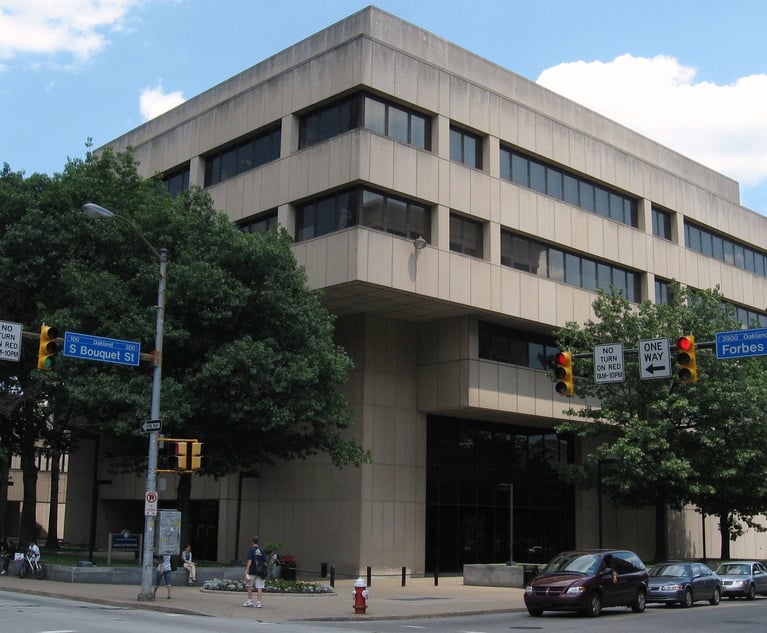Moulton to Take Over as Top Pa. Court Administrator as Darr Announces Retirement
Pennsylvania Chief Justice Thomas G. Saylor announced Darr's retirement and Moulton's ascension to the court administrator role Wednesday afternoon.
July 24, 2019 at 02:46 PM
4 minute read
 H. Geoffrey Moulton Jr., left, and Thomas B. Darr, right.
H. Geoffrey Moulton Jr., left, and Thomas B. Darr, right.
H. Geoffrey Moulton Jr., well-known for reviewing the high-profile prosecution of Jerry Sandusky and for his prolificopinion-writing on the Pennsylvania Superior Court, has been selected to replace Court Administrator of Pennsylvania Tom Darr, who is set to retire at the end of the year.
Pennsylvania Chief Justice Thomas G. Saylor announced Darr's retirement and Moulton's ascension to the court administrator role Wednesday afternoon.
“Geoff Moulton's academic and legal background, coupled with his broad range of experience in the executive legislative and judicial branches render him well qualified to assume the responsibilities of Pennsylvania state court administrator,” Saylor said in a statement released to the media.
Saylor also offered thanks to Darr, who began working for the Administrative Office of Pennsylvania Courts as its director of communications and legislative relations and helped shepherd the office through the development of the Judicial Computer System.
“I would like to express the collective appreciation of the Unified Judicial System for Tom's over 30 years of dedicated service,” Saylor said. “He has served as Pennsylvania's top judicial administrator with professionalism and integrity and he will leave at year end with the thanks of the court and judicial branch for a job well done.”
After joining the AOPC, Darr was appointed deputy state court administrator in 1996, and then as court administrator in 2015. During his 31-year tenure with the AOPC, he helped former Chief Justice Ronald Castille create the Interbranch Commission on Juvenile Justice, and, under former Chief Justice Ralph Cappy, he led the judiciary's role in the design and construction of the Pennsylvania Judicial Center.
Before joining the AOPC, he was deputy secretary for legislative affairs to former Gov. Dick Thornburgh.
“My professional interest from the start has been to encourage collaboration within the court system and between branches of government, as important a goal now as ever but one that is increasingly complex to achieve,” Darr said in the press statement. “It's a great time for Geoff Moulton to use his considerable and diverse experience to take up that challenge for the Supreme Court and with the assistance of a very capable AOPC staff.”
Moulton was appointed to the Superior Court bench in August 2016, and served through December 2017. During that stint, he authored numerous opinions on closely watched issues that were eventually taken up for consideration by the Supreme Court, including whether drug use during pregnancy constitutes child abuse and how overtime should be calculated for salaried employees. In total he wrote 330 opinions as a Superior Court judge, according to the AOPC.
After leaving the Superior Court, Moulton became counsel to the Pennsylvania Supreme Court, a role he is currently serving.
According to the AOPC, Moulton graduated from Columbia Law School in 1984, and subsequently served as a clerk both on the U.S. Court of Appeals for the Second Circuit and the U.S. Supreme Court.
He also spent eight years as a prosecutor in Philadelphia, including four as first assistant U.S. attorney in the Eastern District.
In 2013, then-Attorney General Kathleen Kane also tapped Moulton to act as special prosecutor leading the office's examination of former Gov. Tom Corbett's investigation into allegations of child sex-abuse by Sandusky. Sandusky, a former defensive coordinator for Penn State, was convicted in 2012 on 45 of 48 counts of child sex abuse. Two former university officials ended up pleading guilty to child endangerment in connection with the scandal, and the school's former president was convicted by a jury, but that conviction was later tossed by a federal court.
Although Moulton's report ended up outlining little evidence that the Corbett administration delayed the Sandusky case for political reasons, the review uncovered a trove of pornographic emails that rocked nearly all corners of the state government and eventually led two Supreme Court justices to step down.
This content has been archived. It is available through our partners, LexisNexis® and Bloomberg Law.
To view this content, please continue to their sites.
Not a Lexis Subscriber?
Subscribe Now
Not a Bloomberg Law Subscriber?
Subscribe Now
NOT FOR REPRINT
© 2025 ALM Global, LLC, All Rights Reserved. Request academic re-use from www.copyright.com. All other uses, submit a request to [email protected]. For more information visit Asset & Logo Licensing.
You Might Like
View All

Pennsylvania Law Schools Are Seeing Double-Digit Boosts in 2025 Applications
5 minute read
Pa. Defense Firm Sued by Client Over Ex-Eagles Player's $43.5M Med Mal Win
3 minute read
Am Law 100 Lateral Partner Hiring Rose in 2024: Report
Trending Stories
- 1An Eye on ‘De-Risking’: Chewing on Hot Topics in Litigation Funding With Jeffery Lula of GLS Capital
- 2Arguing Class Actions: With Friends Like These...
- 3How Some Elite Law Firms Are Growing Equity Partner Ranks Faster Than Others
- 4Fried Frank Partner Leaves for Paul Hastings to Start Tech Transactions Practice
- 5Stradley Ronon Welcomes Insurance Team From Mintz
Who Got The Work
J. Brugh Lower of Gibbons has entered an appearance for industrial equipment supplier Devco Corporation in a pending trademark infringement lawsuit. The suit, accusing the defendant of selling knock-off Graco products, was filed Dec. 18 in New Jersey District Court by Rivkin Radler on behalf of Graco Inc. and Graco Minnesota. The case, assigned to U.S. District Judge Zahid N. Quraishi, is 3:24-cv-11294, Graco Inc. et al v. Devco Corporation.
Who Got The Work
Rebecca Maller-Stein and Kent A. Yalowitz of Arnold & Porter Kaye Scholer have entered their appearances for Hanaco Venture Capital and its executives, Lior Prosor and David Frankel, in a pending securities lawsuit. The action, filed on Dec. 24 in New York Southern District Court by Zell, Aron & Co. on behalf of Goldeneye Advisors, accuses the defendants of negligently and fraudulently managing the plaintiff's $1 million investment. The case, assigned to U.S. District Judge Vernon S. Broderick, is 1:24-cv-09918, Goldeneye Advisors, LLC v. Hanaco Venture Capital, Ltd. et al.
Who Got The Work
Attorneys from A&O Shearman has stepped in as defense counsel for Toronto-Dominion Bank and other defendants in a pending securities class action. The suit, filed Dec. 11 in New York Southern District Court by Bleichmar Fonti & Auld, accuses the defendants of concealing the bank's 'pervasive' deficiencies in regards to its compliance with the Bank Secrecy Act and the quality of its anti-money laundering controls. The case, assigned to U.S. District Judge Arun Subramanian, is 1:24-cv-09445, Gonzalez v. The Toronto-Dominion Bank et al.
Who Got The Work
Crown Castle International, a Pennsylvania company providing shared communications infrastructure, has turned to Luke D. Wolf of Gordon Rees Scully Mansukhani to fend off a pending breach-of-contract lawsuit. The court action, filed Nov. 25 in Michigan Eastern District Court by Hooper Hathaway PC on behalf of The Town Residences LLC, accuses Crown Castle of failing to transfer approximately $30,000 in utility payments from T-Mobile in breach of a roof-top lease and assignment agreement. The case, assigned to U.S. District Judge Susan K. Declercq, is 2:24-cv-13131, The Town Residences LLC v. T-Mobile US, Inc. et al.
Who Got The Work
Wilfred P. Coronato and Daniel M. Schwartz of McCarter & English have stepped in as defense counsel to Electrolux Home Products Inc. in a pending product liability lawsuit. The court action, filed Nov. 26 in New York Eastern District Court by Poulos Lopiccolo PC and Nagel Rice LLP on behalf of David Stern, alleges that the defendant's refrigerators’ drawers and shelving repeatedly break and fall apart within months after purchase. The case, assigned to U.S. District Judge Joan M. Azrack, is 2:24-cv-08204, Stern v. Electrolux Home Products, Inc.
Featured Firms
Law Offices of Gary Martin Hays & Associates, P.C.
(470) 294-1674
Law Offices of Mark E. Salomone
(857) 444-6468
Smith & Hassler
(713) 739-1250





